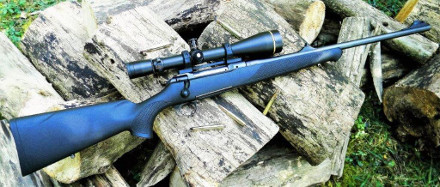
I have used the 110 year old 9.3x62 to take more game than any other cartridge. The first group ever fired from a 9.3x62 was with my own handloads at an Austrian rifle range- three shots into one-half inch at 100 yards- had my interest! The next day, I took eleven Russian boars with thirteen shots, and I’d found a new best shooting friend. For those reasons, I eagerly began this sixth article in the Magic Metrics series, combining one of the oldest hunting calibers with one of the newest rifles, both born in Germany. Since there is so much to cover, it’s best to get right to the point to discuss the features of my chosen test rifle.
Chapter 1: The New Sauer 101 Rifle
Click to LOAD DATA SHEET
When this rifle is first picked up, working the extremely smooth 60 degree lift bolt, and trying the crisp, two-pound trigger, the impression of great quality becomes obvious. Visually, I find it very appealing, from the traditional sculpted Sauer receiver, to the Schnabel tipped forend, as well as how every other part of the rifle flows smoothly from one to the other. At a glance, a shooter can tell that every part of the rifle was engineered- thought and attention went into every piece.
Working the bolt, one enjoys the traditional Sauer smoothness and appreciates the strength that comes from the 6 large locking lugs that directly engage into the breach of the barrel. The hammer-forged barrel is rigidly locked into the receiver by a process called Heat-Lock. The front ring of the receiver is heated, causing it to expand. Then the very close fit barrel is inserted into the hot and slightly enlarged receiver. As the action then cools and shrinks around it, the barrel is tenaciously gripped in place. The result is a stable and tension-free mating of the barrel to the action. Note that the barrel is still replaceable by the factory should the need ever arise.
Sauer’s Dura Safe concept allows for a cocking slide in the bolt shroud to silently activate an internal firing pin block. Moving the safety slide to the rear will result in a locked firing pin. Note that the slide cannot be accidentally moved forward to the Fire position. To make the rifle ready, simply and quietly depress a center button on the cocking...
slide, and push it forward to ready the rifle to fire in one smooth and quiet motion. Additionally, the rifle can safely be unloaded while still in the Safe mode. By depressing a button behind the bolt handle, the chamber can be unloaded with the firing pin still blocked.
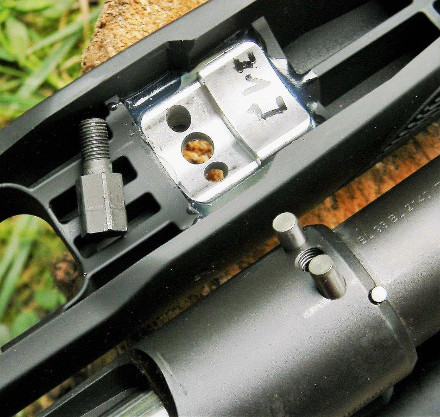
Sauer credits much of the accuracy the rifles deliver to the patented EVERREST action bedding. A machined aluminum block is cemented into the stock which engages with two bolts installed into the bottom of the receiver. This results in external influences having no effect on the accuracy or point of impact. From underneath, a single massive bolt secures the barreled action to the stock. The robust polymer detachable magazine holds five standard cartridges, or four magnums, one more in each case than most other rifles can. The magazine/trigger shroud is made of metal and includes a metal release button, well recessed so as to prevent accidental release.
The soft-touch ERGO MAX stock is pleasing to the eye and engineered to work to the shooter’s benefit. After over 1,000 rounds of 9,3x62 handloads, the gun still looks and handles as if brand new. Engineered at every point to incorporate a smooth working action, outstanding trigger, ergonomic handling, silent safety, a free-floating hammer forged barrel, and good looks… but how will it shoot?
Chapter 2: Factory Ammunition
Four types of factory ammunition were available for testing. From RWS, I had their 258 grain H-Mantel, suitable for most any big game short of African dangerous game. The front portion causes rapid tissue destruction while the rear core continues on for almost certain complete broadside penetration. It averaged 0.62”, 3-shot groups at 100 yards, at a very good speed of 2,435 fps, delivering almost 3,400 ft. lbs. The groups were always nice triangles, something that indicates a balanced load. Nosler provided their Trophy Grade ammo loaded with the 250 grain AccuBond, having a BC of almost .500, so it would retain its velocity very well downrange. It produced 2,340 fps, just over 3,000 ft. lbs., and averaged 0.65”. It would work well if shooting to 200 yards or beyond, on hogs, black...
bear, elk, moose, or larger African plains game.
From the Hornady Dangerous Game series, I shot their 286 grain soft point round, an excellent load for medium to heavy game on any continent. I kept getting two rounds touching, with one slightly out- probably the shooter’s problem… not the ammo. Knuckling down, my final group measured 0.567”- outside to outside, for an actual center-to-center group of only 0.20”! Overall, it was very accurate, with an average group size of 0.53”, at 2,339 fps, producing almost 3,500 ft. lbs.
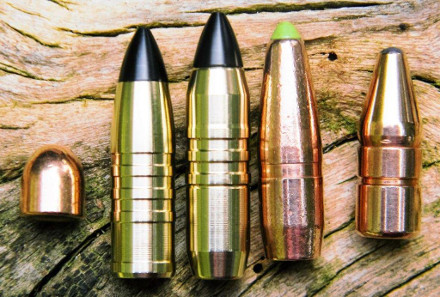
Lastly, down a hot barrel- I’d read that the Sauer will shoot well even if the barrel gets hot- my first shot with the Barnes VOR-TX 286 grain TSX ammunition punched a clean hole in my target downrange. While looking through the Leupold VX-3 scope cranked up to 25 power, my second shot barely made the first hole, just the tiniest bit bigger. Staying calm, I sent the third round downrange. Scope back on target, and I could see that the third bullet just cleaned the “fuzz” out of the small hole made by the first two shots. As best as I can tell, the 3-shot group measures only 0.072”! The load averaged 2,176 fps, producing just over 3,000 ft. lbs. with a very deep-penetrating bullet, and a multiple group, 3-shot average of only 0.48” in the Sauer.
In firing over 200,000 high power rifle rounds over the past four decades, mostly .30 calibers and above, that’s the smallest group I’ve ever fired, and it was achieved using a standard production hunting rifle in what most would consider being a large-bore cartridge. It’d be hard to beat that performance with any other load, but I would have to try with my handloads, knowing now… what a great shooter the Sauer was.
Chapter 3: HandloadingComponents Tested
Over a hundred years ago, it was a simple matter of choosing a 286 grain bullet in soft point or solid, depending on the intended game. Today, we’re blessed with many improved types of bullets which increase the 9.3’s versatility even more. So besides going with the traditional 286 grain bullet, I gathered up as many weights as possible,...
beginning with the 95 grain Speer TMJ RN, meant for the 9 mm Makarov pistol, measuring .364” vs. the Luger’s normal .355” diameter. Why? Because I was curious if a small game/practice load could be developed, so a hunter’s rifle could serve more roles.
Besides that light pistol bullet, I obtained a new 200 grain CNC-turned expanding brass hollow point bullet from Cutting Edge Bullets ( www.cuttingedgebullets.com ), which has a plastic tip covering a unique hexagonal cavity. They also provided their 210 Raptor, 255 grain Safari Raptor, and matching 280 grain Safari Solid. I tested the copper Lapua 220 Naturalis LR (Long Range). Barnes provided their 250s in both the early TSX flat base, and the later tipped and boat tailed TTSX, as well as the heavy 286 TSX. A new lead-free 250 grain GMX came from Hornady to compliment their traditional weight 286 soft point, and a new 300 grain DGS copper-clad steel jacketed bullet for dangerous game.
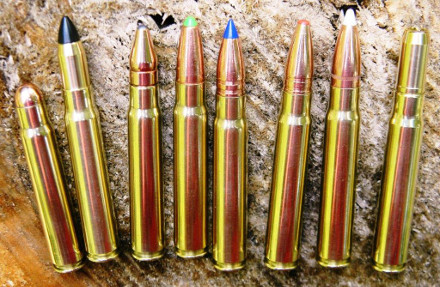
From Nosler, I tested the very high BC, 250 grain tipped boat tail AccuBond, the classic 286 Partition, and the matching 286 Solid. Besides the little pistol bullet, the Speer 270 grain HotCor bullet was tried. Norma’s 286 bonded jacketed Oryx bullet was also included, making for a total of seventeen bullets to accuracy test in the Sauer 101.
Powders tested included those from Hodgdon, Alliant, IMR and Vihtavuori. Many of the bullets did amazingly well with several of the powders, not at all being propellant sensitive. Only Lapua brass was used, full-length sized using Redding dies and their Imperial Sizing Die Wax. All loads were ignited by Federal 210 large rifle primers. A Competitive Edge Dynamics CED M2 chronograph was used to record all velocities. All told, just over 1,000 rounds were loaded and fired for speed and accuracy in the 101.
Chapter 4: Shooting Results
I actually achieved over 3,300 fps with the little 95 grain Speer over faster burning rifle powders, but accuracy was never a constant. Even with the same load, sometimes shooting well, sometimes bad, so I gave up on that. Getting practical, I wanted to see if a light...
small game or practice load could be developed. I succeeded using 22.0 grains of IMR Trail Boss over the TMJ Speer. It delivered almost 1,900 fps and repeatedly grouped into three-quarters of an inch at 50 yards. Besides practice, it might be a good rabbit load, or even a few could be kept in the hunter’s pocket to dispatch fallen big game. Being non-expanding, it might also be suitable on coyotes or fox without harming the pelt. Recoil is almost non-existent, and the report is mild in comparison to full loads.
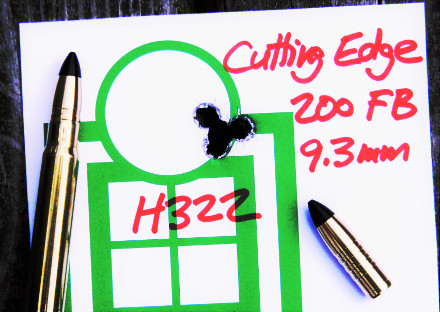
Cutting Edge Bullets makes CNC-turned brass and copper bullets with unique hexagonal cavities in the nose that sort of look inside like a six-point automotive socket. At 1.5 ~ 2” of penetration, the nose ruptures, sending the six blades out in a star pattern, cutting and tearing tissue. Meanwhile, the blunt, sharp-edged base continues on for almost certain complete penetration. I tested the first batch of a new bullet- the 200 grain FB Raptor (flat base) they ran and achieved 0.54 ~ 0.84” 3-shot averages while running it from 2,500 to 2,800 fps. It penetrates far out of proportion to its weight, and would be suitable for most thin skinned game the world over. H322 was the most accurate, good for 0.54” groups at 2,700 fps.
The 220 grain expanding copper Lapua Naturalis is a great hunting bullet. In Australia, I used it on game up to over 1,000 lbs. and was impressed with its shocking power and penetration. Over a half-dozen large game were harvested with no bullet being recovered. It’s a bullet fully adequate for any North American, European or African thin-skinned game. It has a green plastic pointed tip for better down range velocity retention and was capable of hitting almost 2,700 fps.
The 250 grain Barnes TSX and tipped TTSX produced around 2,335 to 2,550 fps and proved to be accurate with a number of powders. With the great penetration they deliver, there’s no need to go up to the traditional 286 grain weight. The relatively new Hornady 250 grain GMX is a guilding metal expanding bullet with a red plastic flat point tip. Speeds ran from 2,250 to 2,550 fps. Only three loads shot just over an inch- all others were smaller. It really loved H322,...
for only 0.52” averages, but my best group with this load was an amazing quarter-inch cloverleaf! I’d be hard pressed to not carry this combination into the field, no matter what game I was after.
Nosler’s 250 grain AccuBond, with its very high BC (Ballistic Coefficient) of almost .500, and of bonded core construction, would do well to 200 yards and beyond on medium to heavy soft-skinned game. The heavier 255 grain Cutting Edge Bullets’ Safari Raptor is a heavy non-tipped version of its lighter offerings. Five loads averaged 0.52 ~ 0.62” for 3-shot groups, using N530, BL-C2, H322, IMR 3031, or H4895. In Australia, this bullet over H4895 dropped large boars where they stood, or they reacted hard, barely making it a few weak steps before collapsing; more about this later.
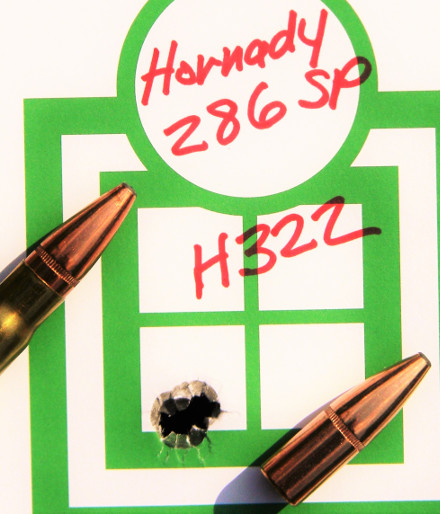
Speer’s 270 grain HotCor semi-spitzer was consistently accurate with all eight tested powders- averaging 0.69 to 0.91”groups- making it easy to find a good-shooting load. The Cutting Edge Bullets’ 280 grain Safari Solid is meant for just that- hunting heavy thin or thick-skinned African game. N540 averaged only 0.57” groups, at 2,316 fps. Note that this bullet also was not particular about what you seat it over. It is generally accurate with every load. Right away I saw lots of promise with the Barnes 286 TSX bullet, as many loads would have two or more bullets almost touching. BL-C2 was excellent at only 0.47” averages, at 2,240 fps form the 22” barrel of the Sauer.
The 286 grain Hornady was a DOOZY in this rifle. Seven powders averaged between only 0.50 to 0.73” for 3-shot groups. But its best group was shot just five loads before the aforementioned Barnes factory round. Again hard to measure, but look at the target- it’s certainly only 0.20”or less for three shots at 100 yards! In all cases above, the barrel was quite warm, having already fired many shots. So that afternoon, in the process of testing many loads, two factory loads and two handloads both using H322, truly produced one-hole groups from a relatively big bore production hunting rifle. I’m amazed at how well a fine hunting rifle with accurate bullets can shoot. It was the best...
shooting day I’ve ever had in my life!
Only a very limited supply of Norma 286 grain bonded Oryx bullets were left, but right away I saw from my targets that it was very accurate and not at all fussy about the propellant I loaded it over. I’ll be certain to obtain Norma Oryx bullets in other calibers and include them in future tests. The 286 Nosler Partitions shot best with N540 at 0.59”, and H322 giving 0.64”. CFE223 again was the fastest powder tested, reaching 2,371 fps. A deep-driving bullet, it would do well on the heaviest of game.
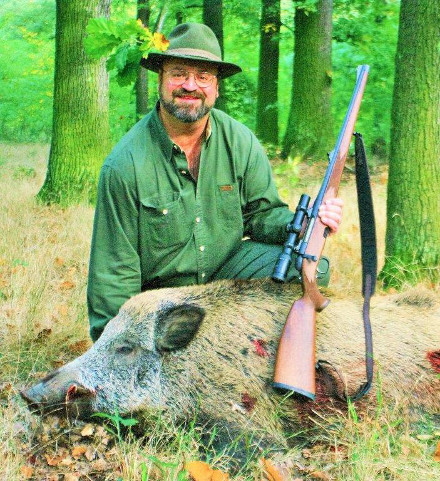
Lastly tested were two non-expanding solids- the solid brass 286 Nosler and the guilding metal clad steel jacketed 300 grain Hornady DGS- Dangerous Game Solid. Both were far more accurate than ever needed from a bullet meant for thick-skinned dangerous game, but still welcome nonetheless. Groups ran between 0.54 to 0.80” with a variety of powders, both not being at all sensitive to the propellant loaded.
Chapter 5: Hunting with the 9.3
The 9.3x62 is, after all, a serious hunting cartridge, so I wanted to share some of the hunting experiences I had with it around the world. The first time I ever hunted with the 9.3 was in Austria, near the Czech border. Participating in my first driven hunt, I amazingly harvested 11 Russian boars with only 13 shots using the 250 grain Barnes TSX over my handloads. The last boar was huge, and given two extra shots, as he just didn’t know it was time to lie down.
In Australia, while hunting on an over 600,000 acre cattle station for wild boars, my friend and I shot dozens of boars in a week, most dropping to the shot from Lapua’s 220 Naturalis, Hornady 286s, Barnes 250s or Cutting Edge’s 255 Safari Raptors. We also had the opportunity to use the very same on much larger animals, going well over 1,000 pounds!
In particular, we were out walking around when our guide- who’d been a meat butcher for over 10 years, shouted out, “Scrub bull! Shoot him, shoot him!” As a cattle breeding station, the goal was to raise prime...
beef, and for that reason they had a very expensive Brahma bull to breed with all the cows. But being as the station was so large, and some cattle were born and died without ever even being seen, they turned “feral” and developed into a line with inferior genes and bad fat-to-meat ratios. The owners didn’t want them breeding with the cows.
So with the bull at around 75 yards and broadside, facing to the right, I threw up my 9.3x62, loaded with 255 Safari Raptors at “only” 2,400 fps, and sent the unique expanding bullet on its way… to the center of his right shoulder. He jumped at the shot, and quickly disappeared behind some brush. We found him not 40 yards away, lying on his left side with a 9.3 caliber hole exactly in the center of his right shoulder. Our guide was amazed that he only went that far. I could stick my index finger through the hole in his shoulder blade. We all three struggled to turn the large bull over so I could recover the bullet from the far side. But when we did, there was another hole in the exact same place where the base of the Safari Raptor exited the far side!
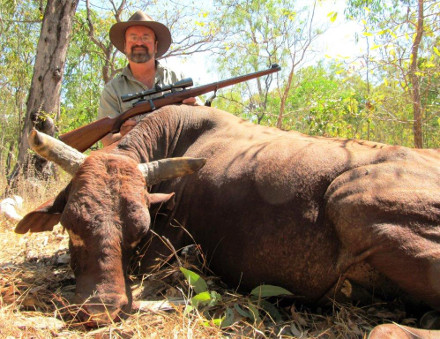
Our guide was amazed, as was I! He stated that the bull easily weighed at least 1,400 lbs- and he’d never seen an expanding bullet break through BOTH shoulder blades of such a large bull. With the right bullets, that’s just exactly what the 9.3x62 is capable of in good hands.
Chapter 6: Summary
I’ve taken more game- and much of it very large- with the 9.3x62 than any other hunting cartridge. From the very first to the last, it always impressed me, and especially my quarry. Otto Bock sure got it right over 110 years ago when he sought to develop a medium bore rifle that’d be suitable for African farmers to take all animals the Dark Continent had to offer.
While this is the first Sauer rifle I’ve ever worked with, it surely will not be the last. For a production hunting rifle, I’m amazed at how well it shot with almost every load tested. I found it hard to believe the very small groups it continued to deliver. Full...
power, or loaded down slightly, it continued to display outstanding performance on the range, just as I know it will in the field. This rifle is not going back to Sauer.
“A check is in the mail,” as we like to say when something is so good it won’t leave our hands.
A grand old cartridge born in Germany, and a new rifle also from the same land is a combination that’s hard to beat… globally, in the hunting field.